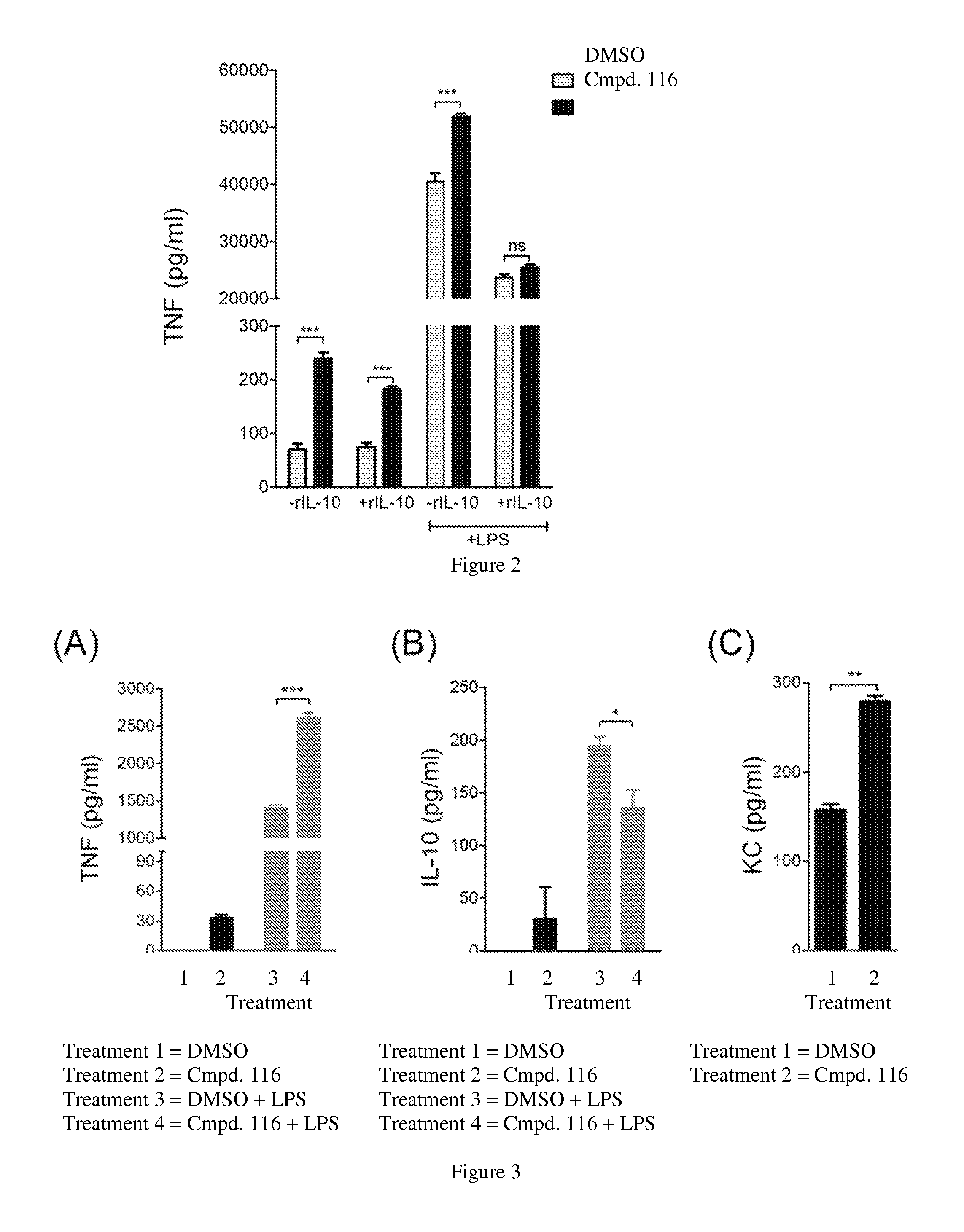Cyclic compounds and methods of making and using the same
a technology of cyclic compounds and compounds, applied in the field of cyclic compounds, can solve the problems of mdr and xdr organisms severely limited their effectiveness, the effect of inhibiting tumor growth, and reducing cancer spread or metastasis
- Summary
- Abstract
- Description
- Claims
- Application Information
AI Technical Summary
Benefits of technology
Problems solved by technology
Method used
Image
Examples
example 1
Synthesis of Compounds
[0488]
General Phenol Alkylation Method: tert-Butyl(3-(3-iodophenoxyl)propyl)carbamate
[0489]To the solution of 3-iodophenol (500 mg, 2.27 mmol) in DMF (3 mL) was added K2CO3 (770 mg, 5.55 mmol), and the resultant mixture was allowed to stir for 20 minutes, followed by the addition of tert-butyl(3-bromopropyl)carbamate (648 mg, 2.70 mmol). The reaction mixture was heated to 45° C. with stilling overnight, and then cooled to room temperature. The solvent was removed under the reduced pressure and the residue was taken up to ethyl acetate (120 mL), washed with citric acid (aq., 10%, 50 mL), water (50 mL), and brine successively. The solution was dried over Na2SO4, concentrated under reduced pressure, and then purified with flash column chromatography (ethyl acetate:hexane=1:5) to yield the product (680 mg, 80%) as a white solid.
[0490]
tert-butyl(3-(3,5-dibromophenoxyl)propyl)carbamate
[0491]Following to the general phenol alkylation method, tert-butyl(3-(3,5-dibromop...
example 1a
Synthesis of Compound 107
[0518]
General Click Chemistry and Deprotection Procedure
[0519]To the solution of 2,7-diethynylnaphthalene (133 mg, 0445 mmol) and tert-butyl(3-(3-azidophenoxyl)propyl)carbamate (247 mg, 0.980 mmol) in t-BuOH (13 mL), were added sodium ascorbate (22.0 mg, 0.111 mmol) and a solution of CuSO4.5H2O (30.0 mg, 0.111 mmol) in water (13 mL). The reaction mixture was allowed to stir for 16 hours at room temperature and poured into water (300 mL). The resultant cloudy aqueous solution was extracted with ethyl acetate (60 mL×3), the organic layer were combined, washed with water, brine, and then dried over Na2SO4. After removal of the solvent under reduced pressure, the residue was purified by flash column chromatography (ethyl acetate:hexane=3:2) to yield the intermediate (320 mg) as an off-white solid. The intermediate was then added into TFA / dicloromethane (2 mL / 4 mL) and the resultant solution was stirred for 2 hours at room temperature. The solvent was removed und...
example 1b
Synthesis of Compound 106
[0520]
General Method of Converting Amino Groups to Guanidine Groups
[0521]To the solution of Compound 107 (130 mg, 0.140 mmol) and N,N-diisopropyl-ethylamine (0.29 mL, 1.68 mmol) in CH3CN / THF (2 mL / 4 mL), was added N,N′-di-Boc-1H-pyrazole-1-carboxamindine (200 mg, 0.630 mmol) at 0° C. The reaction mixture was allowed to gradually warm to room temperature and stirred overnight. The solvent was removed under reduced pressure and residue was taken up to ethyl acetate (50 mL), washed with citric acid solution (aq., 10%), NaHCO3 solution (aq., saturated), and brine successively. The organic layer was separated and dried with Na2SO4, and the solvent was evaporated, followed by the purification with column chromatography to yield the intermediate (140 mg) as colorless oil. The intermediate was dissolved in TFA / DCM (1 mL / 2 mL) and the solution was allowed to stir for 2 hours before removal of the solvent. The residue was washed with methanol for several times and dri...
PUM
| Property | Measurement | Unit |
|---|---|---|
| molecular weights | aaaaa | aaaaa |
| concentration | aaaaa | aaaaa |
| concentration | aaaaa | aaaaa |
Abstract
Description
Claims
Application Information
 Login to View More
Login to View More - R&D
- Intellectual Property
- Life Sciences
- Materials
- Tech Scout
- Unparalleled Data Quality
- Higher Quality Content
- 60% Fewer Hallucinations
Browse by: Latest US Patents, China's latest patents, Technical Efficacy Thesaurus, Application Domain, Technology Topic, Popular Technical Reports.
© 2025 PatSnap. All rights reserved.Legal|Privacy policy|Modern Slavery Act Transparency Statement|Sitemap|About US| Contact US: help@patsnap.com



